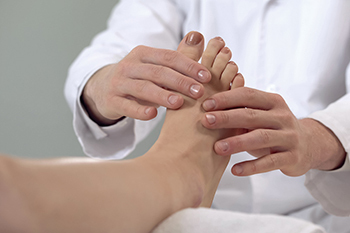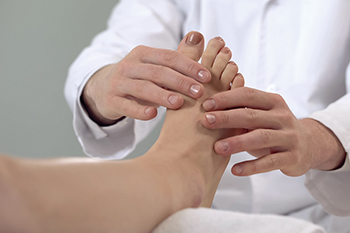September 2022
What Do Cracked Heels Look Like

During the summer months when many people are concerned about how their feet look in sandals, you might hear talk about a foot condition known as cracked heels. This condition, also known as heel fissures, can occur as a result of dry weather and old age, among other causes. Cracked heels can look quite unsightly. Typically, an individual with this condition will exhibit deep cracks at the heel, with calluses surrounding the affected area that might also crack. In a case of heel fissures, the heel might even change colors, being slightly red. In some cases, a person with cracked heels might even see bleeding at the heel. Obviously, none of these visual symptoms are desirable. Prevent or cure cracked heels today by making an appointment with a podiatrist.
Cracked heels are unsightly and can cause further damage to your shoes and feet. If you have any concerns, contact one of our podiatrists from Family Foot Care. Our doctors can provide the care you need to keep you pain-free and on your feet.
Cracked Heels
Cracked heels appear unappealing and can make it harder for you walk around in sandals. Aside from looking unpleasant, cracked heels can also tear stockings, socks, and wear out your shoes. There are several methods to help restore a cracked heel and prevent further damage.
How Do You Get Them?
Dry skin is the number one culprit in creating cracked heels. Many athletes, walkers, joggers, and even swimmers suffer from cracked heels. Age and skin oil production play a role to getting cracked heels as well.
Promote Healing
Over the counter medicines can help, especially for those that need instant relief or who suffer from chronic dry feet.
Wear Socks – Wearing socks with medicated creams helps lock in moisture.
Moisturizers – Applying both day and night will help alleviate dryness which causes cracking.
Pumice Stones – These exfoliate and remove dead skin, which allows for smoother moisturizer application and better absorption into the skin.
Change in Diet
Eating healthy with a well-balanced diet will give the skin a fresh and radiant look. Your body responds to the kinds of food you ingest. Omega-3 fatty acids and zinc supplements can also revitalize skin tissue.
Most importantly, seek professional help if unsure how to proceed in treating cracked heels. A podiatrist will help you with any questions or information needed.
If you have any questions, please feel free to contact our offices located in Valatie and Albany, NY . We offer the newest diagnostic and treatment technologies for all your foot care needs.
Chronic Foot Pain in the Elderly

At least one in four older adults suffers from foot pain. The feet play a critical role in all weight bearing activities as they are the body’s only source of contact with the ground. The feet help with shock absorption, adapt to uneven surfaces, and ease the forward propulsion of the body. If the biomechanical function of the feet is disrupted, it can lead to imbalance, difficulty walking, and ultimately a loss of independence. The most frequently reported problems leading to foot pain in the senior population include corns and calluses, fungal nail infections, and structural deformities, such as bunions and hammertoes. Systemic conditions often associated with foot pain in this age group include arthritis and diabetes. Given that multiple conditions may coexist to cause foot pain, it is suggested that seniors regularly consult with a podiatrist to have their feet examined, obtain proper diagnoses, and get effective treatment that can help restore a pain-free existence.
If you need your feet checked, contact one of our podiatrists of Family Foot Care. Our doctors will attend to all of your foot and ankle needs and provide you with quality treatment.
Geriatrics and Podiatry
When people age, some common issues that may occur are bone density loss, dry skin, poor circulation, and rough brittle nails. These issues may also affect your foot health if the necessary steps are not taken to alleviate the problems.
It is important to take care of your feet because feet that are injured or diseased can affect your overall health. Having painful feet hinders your ability to do daily activities or may decrease your willingness to do the things that you need to do.
Visiting Your Geriatrician
As we age, health problems become more likely, so it is essential to visit your doctor for check-ups to ensure that you are doing the best you can to take care of your health. It is recommended to check your feet frequently for any possible cuts, bruises, swelling, corns or any other irregularities.
Taking Care of Elderly Feet
Cracked or dry feet can be treated by applying moisturizer often. It is also important not to wear old socks because the older the sock is, the higher the possibility there will be that there is bacteria there. Wear fresh socks and make sure they fit properly.
Proper foot health means that you can have a more active lifestyle and you will not be bogged down by pain. Foot health also leads to good circulation, which is paramount for overall health.
If you have any questions, please feel free to contact our offices located in Valatie and Albany, NY . We offer the newest diagnostic tools and technology to treat your foot and ankle needs.
Are Bunions Affecting Your Everyday Life?
Prevention of an Achilles Tendon Injury

Tendons connect muscles to bones. The Achilles tendon, the largest and strongest tendon in the body, connects the lower part of the calf muscles to the heel bone. This tendon helps the calf muscle in pointing the toe or doing a calf raise, and aids in all movement of the ankle joint. When it is overworked or inflexible, it is at risk for injury. Damage to the Achilles tendon can include strain, rupture, or tendinitis. The most common injury to this tendon is tendinitis. This can happen when the tendon is stressed from repetitive movements like running or jumping, or from a change in an athlete’s training program. Additionally, it may happen as a result of training at a level the body cannot handle, or from having inflexible calf muscles. Achilles tendon injuries can be prevented with frequent lower leg stretches, strengthening the calf muscles and Achilles tendon, and engaging in appropriate training for a sport. Shorter, easier workouts should gradually progress to becoming longer, and more difficult. Decreasing the activity that caused pain, and resting are the first things one should do if they have injured their Achilles tendon. If you have pain in your Achilles tendon that continues or worsens, it is suggested that you consult with a podiatrist for a proper diagnosis and treatment plan.
Achilles tendon injuries need immediate attention to avoid future complications. If you have any concerns, contact one of our podiatrists of Family Foot Care. Our doctors can provide the care you need to keep you pain-free and on your feet.
What Is the Achilles Tendon?
The Achilles tendon is a tendon that connects the lower leg muscles and calf to the heel of the foot. It is the strongest tendon in the human body and is essential for making movement possible. Because this tendon is such an integral part of the body, any injuries to it can create immense difficulties and should immediately be presented to a doctor.
What Are the Symptoms of an Achilles Tendon Injury?
There are various types of injuries that can affect the Achilles tendon. The two most common injuries are Achilles tendinitis and ruptures of the tendon.
Achilles Tendinitis Symptoms
- Inflammation
- Dull to severe pain
- Increased blood flow to the tendon
- Thickening of the tendon
Rupture Symptoms
- Extreme pain and swelling in the foot
- Total immobility
Treatment and Prevention
Achilles tendon injuries are diagnosed by a thorough physical evaluation, which can include an MRI. Treatment involves rest, physical therapy, and in some cases, surgery. However, various preventative measures can be taken to avoid these injuries, such as:
- Thorough stretching of the tendon before and after exercise
- Strengthening exercises like calf raises, squats, leg curls, leg extensions, leg raises, lunges, and leg presses
If you have any questions please feel free to contact our offices located in Valatie and Albany, NY . We offer the newest diagnostic tools and technology to treat your foot and ankle needs.
Children's Feet are Different Than Adult's Feet

There are 26 bones in each foot, and they are designed in a complex way to support the body, absorb shock while walking and running, and conform to specific surfaces. When babies are born, their feet are mostly cartilage, which will harden into bones at approximately 13 years of age. The bones will develop gradually, and it is beneficial for them to wear shoes that fit properly when walking begins. Research has indicated the feet grow the fastest in the first three years, and may grow up to nine sizes during that time. Greater activity levels in children produce more stress in the feet than adults, and it is suggested that shoes which have extra cushioning be worn during the early years. Children’s shoes may show wear and tear faster than adult’s shoes, and this may be the result of excess sweating that occurs during physical activities. There are many choices to consider when purchasing children’s shoes, and it is advised that you speak with a podiatrist who can help you to make the right decision for your children’s feet.
The health of a child’s feet is vital to their overall well-being. If you have any questions regarding foot health, contact one of our podiatrists of Family Foot Care. Our doctors can provide the care you need to keep you pain-free and on your feet.
Tips for Keeping Children's Feet Healthy
- Make sure their shoes fit properly
- Look for any signs of in-toeing or out-toeing
- Check to see if they have Clubfoot (condition that affects your child’s foot and ankle, twisting the heel and toes inward) which is one of the most common nonmajor birth defects.
- Lightly cover your baby’s feet (Tight covers may keep your baby from moving their feet freely, and could prevent normal development)
- Allow your toddler to go shoeless (Shoes can be restricting for a young child’s foot)
- Cut toenails straight across to avoid ingrown toenails
- Keep your child’s foot clean and dry
- Cover cuts and scrapes. Wash any scratches with soap and water and cover them with a bandage until they’ve healed.
If you have any questions, please feel free to contact our offices located in Valatie and Albany, NY . We offer the newest diagnostic and treatment technologies for all your foot care needs.







